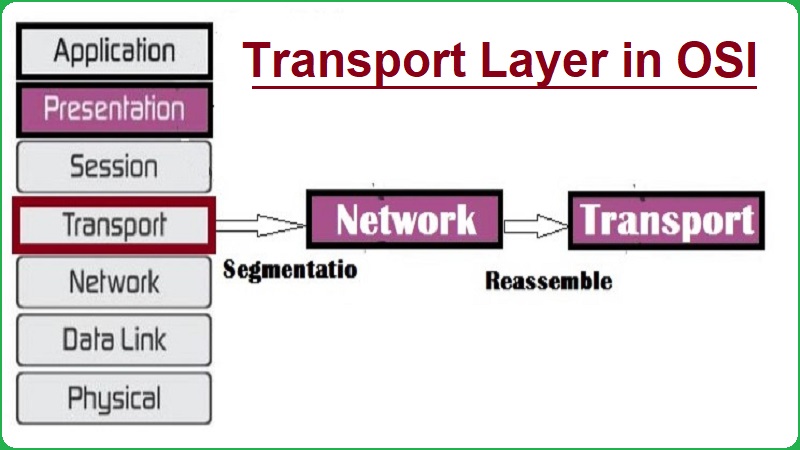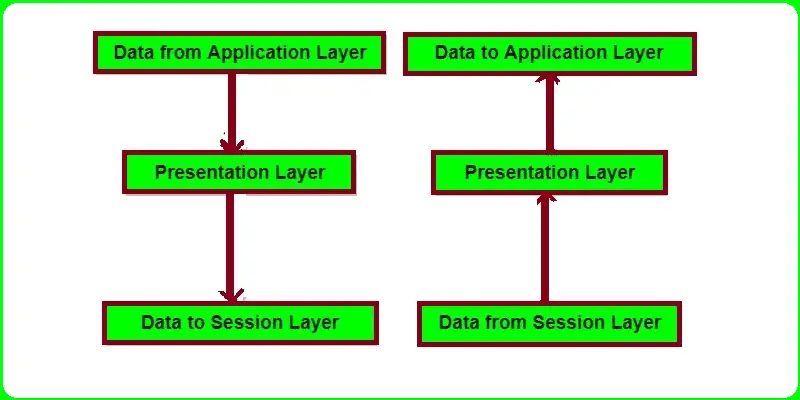What is Transport Layer?
Definition: Transport layer is 4th position in the OSI (Open System Interconnection) model. It’s main goal is to make end to end communication over the network system. And, it also delivers different communication services directly to application processes working on dissimilar various hosts.
Transport Layer in Computer Networks
Transport layer obtains all messages from applications, and transmits those messages into network layer. Then finally, all messages get reassembled into fully fledged messages, and then forward them on to 7th Layer.

Transport layer has different types of protocols like as TCP, UDP, SPX , and more which deliver many group of services over network layer.
Transport layer offers various services like as data transfer, bandwidth guarantees, delay guarantees, and multiplexing/de-multiplexing.
Functions of Transport Layer
Transport layer provides various responsibilities and duties; below explain each one –
Functions and Services Provided by Transport Layer
Data integrity and Error Correction: Transport layer enables with data integrity and error correction because it determine the all errors in the messages which are coming from applications layer with using error detection code and computing checksum.
Also Read: Network Layer in OSI Model with Protocols, Examples, & Functions
It helps to check that obtained data either corrupted or not. And, it used the ACK and NACK services to confirm the sender.
Service Point Addressing: Transport layer header contains port address that enabled with service point address. Network layer grabs the all message to accurate process on the computer system.
Segmentation and Reassembling: One message proceed to split into different segments, and every segment has own sequence number. All messages get reassemble accurately upon reach at the their target point. After that, it will be replacing all packets that destroyed during transmission.
Connection Control: Transport layer has two types of connection control; like as –
- Connectionless Transport Layer: Every segment works as independent packet and forwarded to the transport layer at destination point.
- Connection Oriented Transport Layer: All connections built with transport layer at the target machine. But, this process executes before delivering all packets.
Flow Control: Transport layer allow to be executing all flow control along with end to end.
Congestion Control: Transport layer offers Congestion control in various methods. It deals with Open Loop congestion control to stop the congestion and Close Loop congestion helps to control to discard the congestion in a network that it happened once.
Error Control: Error control also performed with end to end in the transport layer. But, before that entire message must be reaching at the receiving transport layer without getting any error. Now, further error correction get perform though re transmission.
Multiplexing and De-multiplexing: Multiplexing helps to use of various dissimilar applications over the network that is executing on the host, then transport layer offers this types of mechanism system that helps us to move group of packets from several applications same time over the network.
De-multiplexing has to need at the receiver edge to grab all data which are coming from several processes. Transport layer obtains of that data from network layer and finally forwards it to accurate process working on the receiver system.
Transport Layer Protocols
There are various protocols which are using in the Transport Layer; below explain each one –
Examples of Transport Layer Protocols
Transmission Control Protocol (TCP): TCP is getting more popularity for transferring data over the Internet Protocol (IP) and it also known as TCP/IP. Main objective of designing of TCP is to better accuracy, not getting more speed. TCP offers quality of service and flow control.
Also Read: Physical Layer in OSI with Functions, Devices, & Example
User Datagram Protocol (UDP): UDP is very simple Transport Layer communication protocol, and it also referred as UDP/IP suite. This protocol is connection-less and unreliable protocol. So it does not require building connection prior to transfer data.
UDP-Lite: UDP-Lite means Lightweight User Datagram Protocol and this protocol like as User Datagram Protocol because it is also a connection-less protocol. This protocol also serves several applications in error-prone network environments. Where partially damaged payloads prefer to be delivering rather than discarded by the station receiving it.
SCTP (Stream Control Transmission Protocol): It is a standard protocol (RFC 2960), and SCTP introduced by Internet Engineering Task Force (IETF). SCTP is a connection oriented protocol that uses in computer network which offers the full duplex association. And it can be using on the surface of IP network for end to end communication.
SPX (Sequenced Packet Exchange): SPX protocol helps to managing the packet sequencing in the Novell NetWare network but it can also support other operating system. This protocol manages all connections in between systems while transferring of data. So, SPX commands help to build, confirm and close connections.
SST (Structured Stream Transport): SST is an experimental transport protocol that used in the computer networking. It offers an ordered, reliable byte stream abstraction like as TCP protocol.
Features are:
- Multiplexes many application streams onto one network connection
- Gives streams hereditary structure: applications can spawn lightweight streams from existing ones
Micro Transport Protocol (µTP): This is an open UDP-based version of the Bit Laurent peer-to-peer file sharing protocol, intended to reduce the poor latency. And other congestion control problems found in traditional Bit Torrent on TCP, while providing reliable, ordered delivery we do.
Also Read: Data Link Layer in OSI with Protocols, Examples, Functions, & Devices
AppleTalk Transaction Protocol (ATP): ATP protocol provides the simple and efficient mechanism for transferring low amount of data over the network. ATP has better trust level that data transfers without getting any error or packet loss.
Datagram Congestion Control Protocol (DCCP): DCCP protocol helps to reduce overhead of packet header size and it offers the establishment, maintenance and tear down of an unreliable packet flow and the congestion control of that packet flow.
Fiber Channel Protocol (FCP): FCP protocol is using in transport protocol over the IP network. Ans, it helps to transport SCSI commands over the Fiber Channel Network.
Fiber Channel is a high-speed network system that works on high-speed optical fiber cables and serial copper cables. The FC technology introduced to meet the demand for increased speeds of data transfer among computers, servers, and mass storage subsystems.
Multipath TCP (MPTCP): Multipath TCP helps to use of various IP-addresses and interfaces with modification of TCP, and it presents regular TCP interface to other applications as well as spread all data over many sub flows.
Advantages are:
- Good resource utilization
- Best through put and smooth interaction to failures
Reliable Data Protocol (RDP): This is most reliable transport protocol that offers better supporting the massive data transfer of host monitoring and managing several applications, with enabling loading/dumping and remote debugging. Main goal of this protocol is to provide better environments where to transfer non sequential message segment.
Reliable User Datagram Protocol (RUDP): RUDP protocol was designed at Bell Labs for using in Plan 9 operating system. The main objective of RUDP is to offer better solution where UDP is more primitive, so RUDP is getting higher quality of service and it implements all features which are similar to TCP with low overhead.



